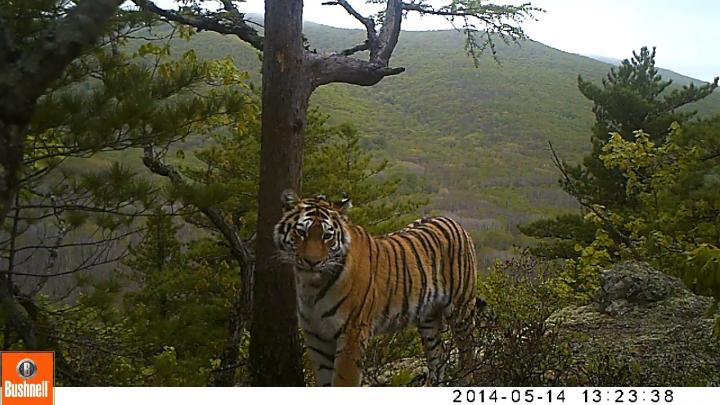Scientists track tigress in Russian Far East and learn there is lots of running around, wolfing down big meals, and then back home to watch the kids

Credit: WCS
VLADIVOSTOK, Russia (December 19, 2019) – A new study by a team of Russian and American scientists revealed the first-ever detailed analysis of a tigress from the birth of her cubs through their first four months. What did they find? Tiger motherhood involves lots of frantic running around, big meals instead of small ones, and constantly checking on the little ones.
Publishing their findings in the journal Mammal Research, scientists equipped an Amur tigress they named Varvara with a GPS collar in the Russian Far East and followed her for eight months: four months before she gave birth to her cubs and four months afterwards. The study is the first to analyze in detail the behavior of a tigress from the birth of her cubs through their first 4 months.
Authors include: Yury Petrunenko of the Far Eastern Branch of Russian Academy of Sciences; Ivan Seryodkin of Far Eastern Federal University; Eugenia Bragina and Dale Miquelle of the Wildlife Conservation Society (WCS); and Svetlana Soutyrina, Anna Mukhacheva, and Nikolai Rybin of the Sikhote-Alin Biosphere Reserve.
The authors found that after having cubs, Varvara immediately shrunk the size of her home range. Then she spent less time moving, but when she did move, it was at a much faster rate to reduce time away from home to keep cubs safe from predators such as leopards, lynx, bears, and wolves. And when it was time to return to the den site she made a “beeline” directly to it, moving much faster compared to other types of movement such as while hunting.
“Female tigers face three major constraints when they rear cubs: they must balance the costs of home range maintenance, they must obtain adequate food to feed themselves (and then the cubs as well as they get older), and they must protect cubs from predation,” said Yuri Petrunenko, lead author of the article. “To protect cubs, they must stay near the den; but to eat, they must leave the den to find, kill, and consume prey, during which time they must be away from the cubs, who face high risks of predation while their mother is out hunting.”
When Varvara’s cubs were young, she killed larger prey than normal, presumably to reduce hunting time, allowing more time at the den with cubs. Once the cubs left the den site (at about two months of age) she was able to spend much more time with them since she could bring them to kills.
Said co-author Dale Miquelle, Director of WCS’s Russia Program: “This study shows that even tigers struggle balancing ‘work’ and ‘family time.’ It’s a constant balancing act to keep their cubs safe while trying to keep themselves fed.”
###
This work was supported by the Mohamed bin Zayed Species Conservation Fund, Panthera, the Liz Claiborne and Art Ortenberg Foundation, Save the Tiger Fund, USFWS Tiger Rhino Conservation Fund, and the Wildlife Conservation Society.
WCS (Wildlife Conservation Society)
MISSION: WCS saves wildlife and wild places worldwide through science, conservation action, education, and inspiring people to value nature. To achieve our mission, WCS, based at the Bronx Zoo, harnesses the power of its Global Conservation Program in nearly 60 nations and in all the world’s oceans and its five wildlife parks in New York City, visited by 4 million people annually. WCS combines its expertise in the field, zoos, and aquarium to achieve its conservation mission. Visit: newsroom.wcs.org Follow: @WCSNewsroom. For more information: 347-840-1242.
Media Contact
Stephen Sautner
[email protected]
718-220-3682
Original Source
https:/
Related Journal Article
http://dx.




